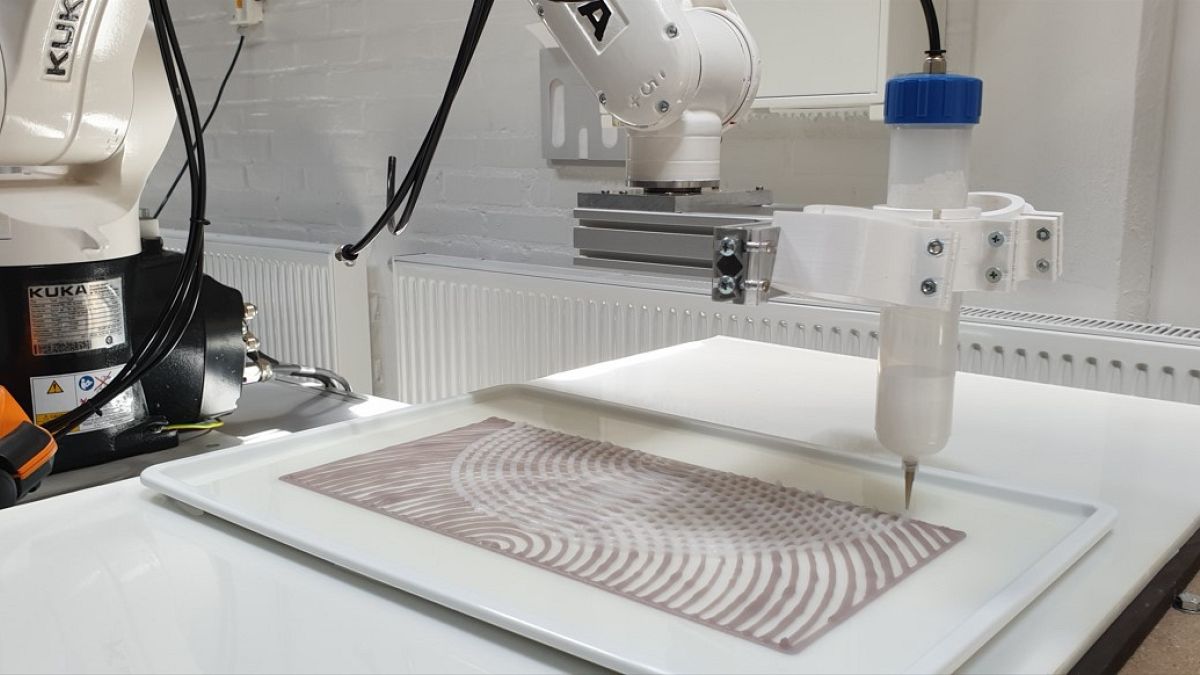The sustainable biomaterial could already be applied as a tiling system for smaller components in buildings.
Scientists have successfully tested a nanocellulose-based biomaterial for greener architecture.
Researchers at Chalmers University of Technology and the Wallenberg Wood Science Centre in Sweden 3D printed a hydrogel material made of nanocellulose, a substance derived from cellulose fibres found in plants.
The nanocellulose 3D-printing technology has been used on a much smaller scale, mostly within biomedicine due to the material’s biocompatibility and wetness. But it has not previously been used as an architectural material, according to the research team.
“It's the first attempt at 3D printing on a larger scale and for architectural applications. The material has been 3D printed before as very tiny objects, within the biomedical industry research. But this is the first time that we have applied it to architecture,” Malgorzata A. Zboinska, an associate professor at Chalmers University of Technology, told Euronews Next.
According to the researcher, nanocellulose forms a very lightweight material when 3D printed and then dried. This means all types of lightweight infill materials that we see in buildings today, such as window screens, solar shading blinds, acoustic panelling systems and parts of room dividers, could be replaced.
“There is a wide array of potential applications,” said Zboinska.
The team started with prototypes as small as a matchbox and scaled up to the current size of A4 paper. It could already be applied as a tiling system for smaller components in buildings.
“So you could assemble multiple pieces together, for example, to use as wall cladding, or instead of maybe wallpaper or other materials that we have in buildings. But of course, there is the potential to scale up even more to have larger pieces that could cover entire walls,” said Zboinska.
To produce a 3D-printable material, the research team added an algae-based material called alginate, which makes the nanocellulose material more flexible when dried.
Working with hydrogel requires meticulous calibration as it has both pros and cons.
“The hydrogel has a property that makes it not flow when it's being 3D-printed, so it doesn't liquefy, it stays in its shape exactly how we want it to be,” said Zboinska.
“On the other hand, because it's a hydrogel, it contains a lot of water. So there are challenges related to the drying of the material where we are dealing with shrinkage and some deformations within the material. But this can also be mitigated if we design the 3D-printing paths in a good way”.
Greener building materials are crucial for sustainable transition
The construction sector is responsible for over 35 per cent of the EU’s total waste generation, according to the European Commission and experts say greener building materials are crucial to transitioning to a sustainable future in line with the European Green Deal.
The research team says the nanocellulose used in this study can be found easily in forestry, paper mills and agriculture such as straw residues.
“Instead of turning these products into waste, we're trying to use the material to create new materials. And it contains only these very tiny cellulose fibres, mixed with water,” said Zboinska.
The technology is also highly energy-efficient thanks to the shear-thinning properties of the nanocellulose hydrogel.
This means the nanocellulose hydrogel liquefies when pressure is applied, allowing it to be 3D printed, but when the pressure is taken away it maintains its shape.
“We're not really using any heat. We're 3D printing at room temperature, which is very important if we're considering how the material is being manufactured. The fabrication method is also sustainable,” said Zboinska.
The technology is not yet ready for building exterior materials and the research team will continue to focus on interior applications.
The team hopes research like this can offer fundamental knowledge to designers and engineers so “our buildings are much more sustainable and green” in the future.
“The plan is to continue to work with the scalability of the material and possibly also to prepare a large-scale prototype…We're hoping to get as extensive as possible array of applications,” said Zboinska.
For more on this story, watch the video in the media player above.



